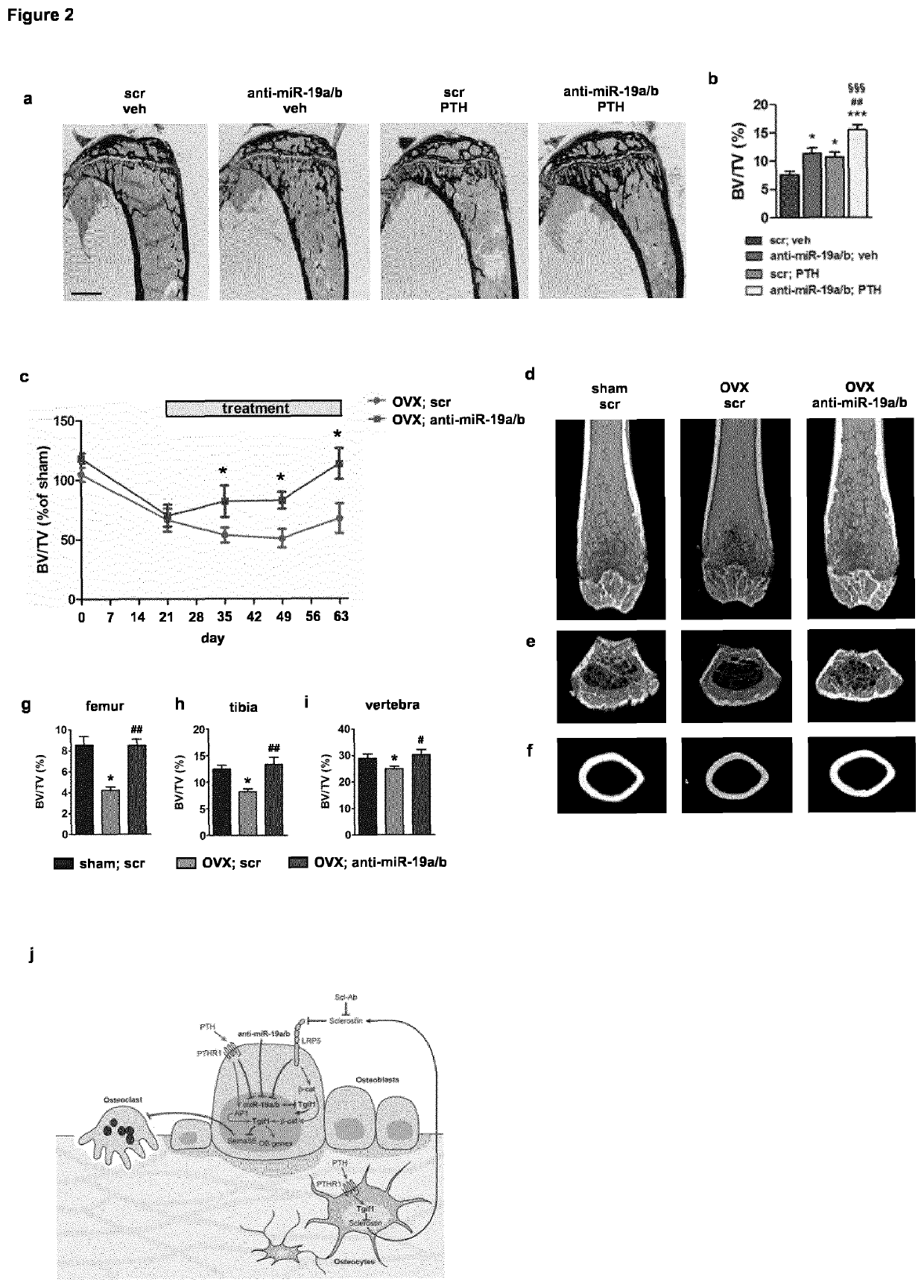Microrna 19a/19b for use in treating a pathological condition associated with bone loss or reduced muscle function
a technology of pathological conditions and microrna, which is applied in the direction of muscular disorders, drug compositions, peptide/protein ingredients, etc., can solve the problems of poor bone quality, short stature and inability to walk, and bowed arms and legs, etc., to achieve normal height and lifespan, short stature, and little or no trauma
- Summary
- Abstract
- Description
- Claims
- Application Information
AI Technical Summary
Benefits of technology
Problems solved by technology
Method used
Image
Examples
example 1
nalysis of miRNA Expression
[0042]To identify miRNAs that are regulated in response to a bone anabolic stimulus, we injected 8-week old mice with a recombinant fragment of human parathyroid hormone (PTH1-34) or an antibody against sclerostin (Scl-Ab). Specifically, wild type male mice were injected with vehicle, 100 μg / kg PTH1-34 (Bachem) or 100 μg / kg Scl-Ab. After 4 hours, total RNA including small RNAs was isolated from mouse bones using Trizol (Invitrogen) according to instructions provided by the manufacturer. For expression analysis, cDNA was synthesized from 1 μg of total RNA using ProtoScript First Strand cDNA Synthesis Kit (NEBioLabs). Quantitative real-time PCR (qRT-PCR) was performed with the CFX96 detection system (BioRad) using SYBR Green Master Mix (BioRad). After normalization to TATA-binding protein (Tbp) mRNA, relative expression levels and fold induction of each target gene were calculated using the comparative CT (ΔΔCT) method. Small RNAs were isolated from various ...
example 2
Analysis of miRNA Expression
[0044]For testing the effect of a stimulation of calvarial osteoblasts with PTH1-34 and Wnt3a, an in vitro assay was performed. Calvarial osteoblasts were isolated from 2-3-day old mice and expanded in α-MEM containing 10% FBS and P / S. Osteoblasts were stimulated with vehicle, PTH 1-34 (100 μM) or Wnt3a (100 ng / ml) for 4 hours and small RNAs were extracted from cells using the miRNEasy kit (Qiagen). After cDNA synthesis, expression of miR-19a and miR-19b was analyzed using qRT-PCR. U6 expression was used as internal control, and the relative miRNA expression was calculated using the ΔΔCT method.
Results:
[0045]Both the stimulation with PTH1-34 and Wnt3a induced a reduction in miR-19a / b expression in calvarial osteoblasts (FIG. 1c).
example 3
Analysis of Osteoblast Differentiation
[0046]To test whether the differentiation of calvarial osteoblasts can be influenced by interfering with miR-19a / b expression, the cells were transfected with oligonucleotides that are designed to bind to and inhibit endogenous miR-19a (anti-miR19a: 6-FAM / TGCATAGATTTGCAC) and miR-19b (anti-miR-19b: 6-FAM / TGCATGGATTTGCAC). These synthetic oligonucleotides contain phosphorothioate backbone bonds for optimal use in functional studies as well as optimized pharmacokinetic and pharmacodynamic properties and minimal toxicity. Furthermore, the 5′ fluorescein FAM label allows monitoring of transfection efficiency in vitro and tissue delivery in vivo. The cells were transfected with anti-miR-19a / b (50 nM) using the Neon electroporation system (Invitrogen). Osteoblast differentiation was induced by supplementing α-MEM with 0.2 mM L-ascorbic acid and 10 mM β-glycerophosphate (both Millipore). Osteoblast differentiation was determined by alkaline phosphatase...
PUM
| Property | Measurement | Unit |
|---|---|---|
| time | aaaaa | aaaaa |
| isotropic voxel size | aaaaa | aaaaa |
| fragility | aaaaa | aaaaa |
Abstract
Description
Claims
Application Information
 Login to View More
Login to View More - R&D
- Intellectual Property
- Life Sciences
- Materials
- Tech Scout
- Unparalleled Data Quality
- Higher Quality Content
- 60% Fewer Hallucinations
Browse by: Latest US Patents, China's latest patents, Technical Efficacy Thesaurus, Application Domain, Technology Topic, Popular Technical Reports.
© 2025 PatSnap. All rights reserved.Legal|Privacy policy|Modern Slavery Act Transparency Statement|Sitemap|About US| Contact US: help@patsnap.com



